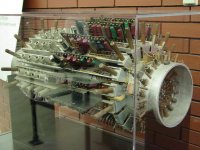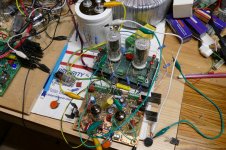We Brits did it with octal tubes in the 1940s.
File:Colossus Computer, Bletchley Park - geograph.org.uk - 1590871.jpg - Wikimedia Commons
And you Brits invented the stored-program concept in 1936 (Turing, "On computable numbers, with an application to the Entscheidungsproblem"), were the first to have a stored-program computer running in 1948 (Manchester Baby), and even had a design for a Harvard architecture machine way back in the 1800's (Babbage Analytical Engine).
Pah, valves. Too new-fangled. You need lumps of brass and steel!
Thomson'''s (Lord Kelvin) First Tide Predicting Machine, 1876 | Science Museum Group Collection
Thomson'''s (Lord Kelvin) First Tide Predicting Machine, 1876 | Science Museum Group Collection
Member
Joined 2009
Paid Member
Bigun, do you have a schematic for that build? I have some spare tubes...

I would love to get my hands on pieces of that machine. The photo I posted was apparently a unit made by IBM although I'm doubtful myself if that's true or was intended to be a pun.
I remember working at JET at Culham Laboratories on Norsk Data mini-computers and 5 1/4" floppy discs - they were state of art at that time. No valves.
I watched IBM remove the valve equipped 709 at UCLA, and replace it with the solid-state 7094. I used to have one of the "pluggable units" that appeared to have a couple core memory parts and a couple small tubes. Dozens of diodes, and all hand wired... I don't know what happened to it over the last 50 or 60 years....
Not yet, but it's on my list! Bletchley Park is well worth a visit, but when I went the two museums were having a bit of a tiff, and you couldn't get a joint entry, I think they've made up now though.
I was there on Thursday 11 June 2015. Back then you needed to buy separate tickets for the part the Bletchley Park Trust takes care of and for The National Museum of Computing. As far as I know that's still the case. The rebuilt bombe is now in The National Museum of Computing, by the way. See Visit The National Museum of Computing | The National Museum of Computing for the (rather limited) opening times of TNMOC.
Last edited:
Pah, valves. Too new-fangled. You need lumps of brass and steel!
Thomson'''s (Lord Kelvin) First Tide Predicting Machine, 1876 | Science Museum Group Collection
Kelvin was only 2000 years behind the curve.
Antikythera mechanism - Wikipedia
I have explained before how I came to posses over 100,000 vacuum tubes.
Short story is that a surplus dealer had passed away maybe 10 years previously and his large warehouse full of junk was left behind, unclaimed. After about 10 years a new owner would take possession of the property and brought in the bulldozers to demolish the derelict building. As the demo started someone found hazardous materials (mercury from some tubes) and everything came to a halt.
My friend, another surplus dealer, made an offer to clear the hazmat along with the entire contents, and I got all the tubes in exchange for the physical labor.
The warehouse had been in disrepair for years and had obviously been previously occupied by squatters who had fun destroying stuff. Later it would be occupied by birds (mostly pigeons), snakes, spiders, rats and other creatures. Everything was coated in crap.
My friend made money selling the aircraft surplus, I spent 5 years sorting through a couple tons of vacuum tubes to pick out the useful stuff. Many were "computer tubes" from the 1950's, and some had the IBM brand on them. There were shelves containing several hundred of those "pluggable units." All went to the metal scrapper, as did most of the other electronics.
In a different adventure I got a call from a friend who usually did land clearing, but did most anything for $$$$. He told me to wear old clothes, bring hammers, an axe, and any other implements of destruction that I could think of, and show up at dawn at an address in a warehouse district. I would learn the "mission" once I arrived.
Upon arrival I was met by a couple of suits. The warehouse was a data processing center for a chain of banks......the mission.....total destruction of an old leased IBM mainframe system. It was being scrapped and replaced with a more modern computer. The stuff that was important to IBM was already gone, as was all the data storage media (disk packs and tapes). The suits were there to see that nothing left the grounds in usable condition, beyond that they didn't care. My mission was to render stuff "unusable." An axe or pickaxe whack or two was sufficient.
My friend and another person he brought were there for the gold scrap. They knew what parts of the computer held the treasure, as did the suits. That stuff filled a full size van and a pickup truck. It seemed they were after the ceramic chips and some hybrid modules. Most of the heavy metal stuff went into a dump truck for metal salvage.
I managed to convince one of the suits to let me take home a large power supply unmolested except for the tag with all the numbers on it. I also brought home one of the large heavy rack frames, minus the skins with the IBM logo, but once I got it home I found out that it was larger than a standard 19 inch width, thus useless to me.
Short story is that a surplus dealer had passed away maybe 10 years previously and his large warehouse full of junk was left behind, unclaimed. After about 10 years a new owner would take possession of the property and brought in the bulldozers to demolish the derelict building. As the demo started someone found hazardous materials (mercury from some tubes) and everything came to a halt.
My friend, another surplus dealer, made an offer to clear the hazmat along with the entire contents, and I got all the tubes in exchange for the physical labor.
The warehouse had been in disrepair for years and had obviously been previously occupied by squatters who had fun destroying stuff. Later it would be occupied by birds (mostly pigeons), snakes, spiders, rats and other creatures. Everything was coated in crap.
My friend made money selling the aircraft surplus, I spent 5 years sorting through a couple tons of vacuum tubes to pick out the useful stuff. Many were "computer tubes" from the 1950's, and some had the IBM brand on them. There were shelves containing several hundred of those "pluggable units." All went to the metal scrapper, as did most of the other electronics.
In a different adventure I got a call from a friend who usually did land clearing, but did most anything for $$$$. He told me to wear old clothes, bring hammers, an axe, and any other implements of destruction that I could think of, and show up at dawn at an address in a warehouse district. I would learn the "mission" once I arrived.
Upon arrival I was met by a couple of suits. The warehouse was a data processing center for a chain of banks......the mission.....total destruction of an old leased IBM mainframe system. It was being scrapped and replaced with a more modern computer. The stuff that was important to IBM was already gone, as was all the data storage media (disk packs and tapes). The suits were there to see that nothing left the grounds in usable condition, beyond that they didn't care. My mission was to render stuff "unusable." An axe or pickaxe whack or two was sufficient.
My friend and another person he brought were there for the gold scrap. They knew what parts of the computer held the treasure, as did the suits. That stuff filled a full size van and a pickup truck. It seemed they were after the ceramic chips and some hybrid modules. Most of the heavy metal stuff went into a dump truck for metal salvage.
I managed to convince one of the suits to let me take home a large power supply unmolested except for the tag with all the numbers on it. I also brought home one of the large heavy rack frames, minus the skins with the IBM logo, but once I got it home I found out that it was larger than a standard 19 inch width, thus useless to me.
Those "plugable units" have the Tektronix look, also seen in post WWII military stuff. Some units were so neat with every wire laced into place and every unit was identical even though they were hand built.
When I first came to Motorola there were several assembly lines. Most were the usual setup for stuffing boards, but there was two areas segregated from the rest of the plant.
One built radio equipment for aircraft service. Some of the stuff even ran on tubes, a pair of 12AX7's. I asked why this was still being built in 1973 and was told that the new solid state unit had been designed for several years, but was still tied up in the FAA approvals process. This thing went into commercial passenger aircraft and had to be approved individually for each different aircraft type it would be used in.
The other was the BBT line. BBT stood for Building Block Terminals, basically a dedicated minicomputer for operating a paging terminal. There were several rack mounted "building blocks" which could be interconnected in dozens of ways to create a system that would answer the phone lines, store the messages, maintain a data base, and operate one or many radio transmitters. I got to see how these fancy laced wire harnesses were created......with a high tech assembly jig made from plywood, nails and Destaco clamps.
When I first came to Motorola there were several assembly lines. Most were the usual setup for stuffing boards, but there was two areas segregated from the rest of the plant.
One built radio equipment for aircraft service. Some of the stuff even ran on tubes, a pair of 12AX7's. I asked why this was still being built in 1973 and was told that the new solid state unit had been designed for several years, but was still tied up in the FAA approvals process. This thing went into commercial passenger aircraft and had to be approved individually for each different aircraft type it would be used in.
The other was the BBT line. BBT stood for Building Block Terminals, basically a dedicated minicomputer for operating a paging terminal. There were several rack mounted "building blocks" which could be interconnected in dozens of ways to create a system that would answer the phone lines, store the messages, maintain a data base, and operate one or many radio transmitters. I got to see how these fancy laced wire harnesses were created......with a high tech assembly jig made from plywood, nails and Destaco clamps.
I Worked in the Electronics Pool while in the NAVY in Jacksonville FL in the early 1970s.
One of the things I learned while working on HF equipment was lacing. I still do some on rare occasions and have spools of both black and white lace.
It just looks so much better than Ty-Wraps.
One of the things I learned while working on HF equipment was lacing. I still do some on rare occasions and have spools of both black and white lace.
It just looks so much better than Ty-Wraps.
So who here will be the first in this thread to make a component for a modern vacuum tube computer.
Challenge:
Design and Build a working component of any microcomputer or basic calculator or modern computer using at least one vacuum tube.
Component must provide a crucial role in the operation of a DIY computer or basic calculator, involving either memory, function or logic centers.
Alternatively I would love to hear how tubelab is going with that vacuum tube amp in a computer project he is doing...
Challenge:
Design and Build a working component of any microcomputer or basic calculator or modern computer using at least one vacuum tube.
Component must provide a crucial role in the operation of a DIY computer or basic calculator, involving either memory, function or logic centers.
Alternatively I would love to hear how tubelab is going with that vacuum tube amp in a computer project he is doing...
Last edited:
Member
Joined 2009
Paid Member
LOL. That's true craftsmanship and skill.I got to see how these fancy laced wire harnesses were created......with a high tech assembly jig made from plywood, nails and Destaco clamps.
Design and Build a working component....
When some big companies lose market share in their respective business they start, or morph into a school. Control Data Corporation was one of the biggies in the monster mainframe business. Sometime in the mid 60's they started the Control Data Institute to teach people how to fix, set up, program and operate those monsters. There was such a school in Miami Florida. There were commercials on the Miami TV stations offering an expensive education in the "exciting field of computers."
There were several technical high schools in the Miami area, some of which taught electronics, mainly from a TV repair viewpoint. I went to one of those high schools. We went on "field trips" to places like Solitron Devices where mil spec transistors were made, the RCA computer plant where mainframes were assembled, Simpson Marine Electronics, and yes, the Control Data Institute who gave us a day long deep dive into the school, half of which was a sales pitch.
I remember seeing a partial tear down of a "CPU rack." It had lots of plug in PC boards each about 3 X 5 inches in size that contained a few discrete transistors and performed a basic logic function like a gate or flip flop. I asked why it didn't use chips and got a story about reliability. I'm guessing that it was not a current generation computer.
I had already started construction on my dream digital music synthesizer that DID use RTL chips for the basic logic functions by the time of this tour. I still have those boards and I need to fire one or two up to see if they have survived for about 50 years.
It would be possible to make a basic logic function from a tube or two. A simple OR gate could be created from a 6AL5 dual diode and a buffer of some sort, a flip flop can be built with a 12AU7.....but why? If I'm going to make a complex system out of tubes, it's going to be a music synthesizer.
I would love to hear how tubelab is going with that vacuum tube amp in a computer project he is doing...
That's temporarily on hold again, this time for a good reason. I have fought what's now called ADHD my entire life. This leads to several unfinished projects at any given moment with indecision on how to proceed on any one of them common and the desire to toss it and start over sometimes winning out ofer solving a minor problem. I have learned not to toss the incomplete or failed projects since I may find the clue to it's success right after I give up.
Several years ago I started on a radical new concept in vacuum tube / hybrid circuitry. Of course something like this doesn't work on the first, or fiftieth try. It gets tossed into the "box of broken dreams" often, only to be retrieved later and blown up again. A discussion in the instruments and amps forum provided the spark that dug that long sleeping (years) project out of the "box" for another experiment, which led to.....a working amp!
As I type this I have an Eagle PCB design open in another window. Its the first step in turning this furball of parts into a reproducible amp design. This should be scaleable from about 10 WPC to 500 WPC, but only time will tell if I'm right. Either way, it's got most of my tube time right now.
The PC / guitar amp is a cool idea, but it's not high enough up on the list right now to get much attention, especially since I can plug my guitar right into my studio PC and do the same thing right now.....it's just not too portable.
I have included a picture of the mid power (50 watt) furball design, and a random cool picture I found in my camera that I took last week. There is a tiny baby fawn sleeping in my back yard while a blue heron is flying down the creek looking for it's breakfast. The bird is larger than the deer! I haven't seen the deer since, and it's odds of survival are slim since there are several predators like coyotes and foxes that would eat it for breakfast.
Attachments
- Status
- This old topic is closed. If you want to reopen this topic, contact a moderator using the "Report Post" button.
- Home
- Member Areas
- The Lounge
- Valve based computers


